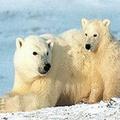 布希政府5月14日勉強地發表聲明將北極熊列為生存受到威脅的物種,並表示北極海的冰層融失已經對這種標竿物種的未來造成危害。但是布希政府也採取行動來確保這項決策將不需要增加遏止全球暖化的新作為,也不會對北極熊棲地的石油及天然氣發展增加新的限制。
布希政府5月14日勉強地發表聲明將北極熊列為生存受到威脅的物種,並表示北極海的冰層融失已經對這種標竿物種的未來造成危害。但是布希政府也採取行動來確保這項決策將不需要增加遏止全球暖化的新作為,也不會對北極熊棲地的石油及天然氣發展增加新的限制。
這項聲明終止了一個3年的法律爭議,這項爭議主要訴求是北極熊棲地在全球暖化衝擊下,北極熊是否應該列為「瀕危物種法案(Endangered Species Act)」中的生存受威脅物種。三個環保團體首先在2005年提出此項北極熊列冊保護的請願書。
美國漁業暨野生動物局(U.S. Fish and Wildlife Service)錯失在2008年1月份作出決議的截止日期,然而在法院命令下,仍必須在5月15日作出決議。
美國內政部長坎培松(Dirk Kempthorne)告訴記者:「我希望可以有不同的決議」。他抱怨地表示:「我被這種沒有彈性的法律限制住了」。坎培松指出,越來越多證據顯示北極熊因為冰層溶解而身陷危機,這使得他不得不將這種物種列入保護清單中。「瀕危物種法案」要求這項決議要以現有最好的科學證據作為後盾。
雖然大約還有22000頭北極熊散居在北極地區,包括在美國境內的4700頭,升高的氣溫還是使這個物種陷於困境之中。
一項在2007年秋天由美國地質調查局(the U.S. Geological Survey, USGS)發表的關鍵性科學研究顯示,由於氣溫上升使海洋冰層融解的狀況加劇,包括美國境內在內的全球2/3北極熊將可能在2050年之前消失,因為北極熊必須仰賴海洋冰層來獵捕食物。
美國地質調查局的研究充斥了令人驚訝的證據,這些證據顯示北極融失的速度比預期還要快,去年融失的冰層已經達到預計在這世紀中才會發生的狀況。有些科學家現在預估北極將可能在2012年暑假就成為無冰狀態。
 坎培松表示,棲息地的融失使北極熊在「可見的未來」陷入成為瀕危物種的危機,因此符合列入生存受威脅物種的條件。
坎培松表示,棲息地的融失使北極熊在「可見的未來」陷入成為瀕危物種的危機,因此符合列入生存受威脅物種的條件。
將北極熊列入清單中需要聯邦部門保證他們所授權、資助、或執行的任何行動都不會危害北極熊的持續存在,或是對他們的關鍵棲地進行不可彌補的作為。
此外,美國漁業暨野生動物局還必須為北極熊準備一個復育計畫,這個計畫中必須明確指出保護北極熊的必要方法。
然而這個美國內政部總管馬上就採取行動來限制將北極熊列入清單所造成的衝擊,同時確認這項決議「不會被濫用來制定全球暖化政策」。
他強調那個決策將不會對產生二氧化碳及其他溫室氣體活動的管制開方便之門。
The Bush administration reluctantly declared the polar bear a threatened species today, concluding that the loss of Arctic sea ice has put the future of the iconic species in peril. But the administration also took steps to ensure the decision will not require new efforts to tackle global warming or put new restrictions on oil and gas development in polar bear habitat.
The announcement ends a three-year legal dispute over whether the polar bear should be listed as threatened under the Endangered Species Act because of the impact of global warming on its Arctic habitat. Three conservation groups first filed a petition requesting the decision in 2005.
The U.S. Fish and Wildlife Service missed a January deadline to issue a decision and was under a court order to finalize its decision by Thursday.
"I wish the decision could be otherwise," U.S. Interior Secretary Dirk Kempthorne told reporters, bemoaning the "restraints of the inflexible law that guides me."
Kempthorne said the growing body of evidence that the polar bear is at risk from melting sea ice left him with little choice but to list the species. The Endangered Species Act requires that the decision is supported by the best available science.
Although there are an estimated 22,000 polar bears spread across the Arctic, including some 4,700 within the United States, there are worrying signs that rising temperatures have put the species in jeopardy.
A key scientific study issued last fall by the U.S. Geological Survey, USGS, found that two-thirds of the world's polar bears, including all those within the United States, could disappear by 2050 due to increased sea ice melt caused by rising temperatures. Polar bears rely on sea ice to hunt for prey.
The USGS research came amid startling evidence that the Arctic is melting faster than predicted, as ice loss last year reached levels not predicted to occur until mid-century. Some scientists now predict the Arctic could be ice-free in the summer as early as 2012.
The loss of habitat puts polar bears at risk of becoming endangered in the "foreseeable future," Kempthorne said, and thus meets the criteria for the species to be listed as threatened.
Listing the polar bear requires federal agencies ensure that any action they authorize, fund, or carry out will not jeopardize the polar bears' continued existence or adversely modify their critical habitat.
In addition, the Fish and Wildlife Service must prepare a recovery plan for the polar bear, specifying measures necessary for its protection.
But the Interior chief immediately took steps to limit the impact of the listing and make sure it "isn't abused to make global warming policies."
He stressed that decision will not open the door to restraints on activities that produce carbon dioxide and other greenhouse gases.
全文及圖片詳見:ENS





